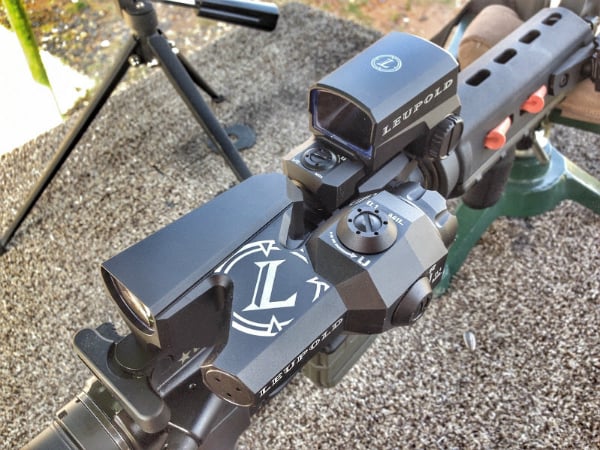
Last Updated on
By Kip Staton
The AR-15 family of weapons has proven to be the most versatile set of rifles ever devised. They’re equally at home clearing a small, dusty room in the Middle East or harvesting game in the Eastern United States.
These guns have little else to prove and are fully capable of going from zero to 600 meters and beyond. In general, ammunition and optics are the limiting agents when using the AR-15.
The rifle’s general usefulness both up close and far away presents some interesting challenges when selecting glass. For instance, scopes that are good at distance aren’t normally ideal for up-close situations, and vice-versa.
This disparity normally means that a variable power optic like the Vortex Razor HD Gen II 1-6×24 is the best solution to get the most out of your rifle. But even these tools have their limitations.
Swinging the power adjust ring from 1x to 6x takes time and requires the sight picture to be lost to avoid unnatural contortions during the change.
It can also be very expensive to achieve a true 1x magnification with a variable powered scope. And it’s very rare to find one that works to the same degree of efficiency as a red dot. What’s a shooter to do?
Two Optics?
Piggy-backing a red dot on a magnifying optic (like the semi-common ACOG/RMR combos) works, as does hanging the dot off the gun at a forty-five degree angle in conjunction the primary optic.
These solutions are definitely faster than the low power variable when switching from near to far, but still require head and/or gun movement. They almost always sacrifice a normal cheek weld when switching views.
Leupold has addressed this near/far optics issue for the AR-15 and similar rifles with a rather unique take on the two-optic solution: The D-EVO (Dual-Enhanced View Optic) and LCO (Leupold Carbine Optic). But understanding how these two rifle scopes work together takes a bit of explaining.
So, what is the D-EVO/LCO?
At first glance, it’s difficult to decipher exactly what’s going on with the D-EVO and LCO. First, it’s important to recognize that they are indeed two completely separate optics.
The D-EVO is a fixed-power 6×20 magnifying scope with the excellent CMR-W DEVO reticle, and the LCO is an advanced red dot with some pretty nifty features.
Comparing the D-EVO and LCO combo to the simple idea of the tall, see-through scope rings of days gone by will get the point across fairly well. These scopes present two different, near-simultaneous sight pictures: One at 6x, and one at 1x. The benefits of this to a capable rifle like the AR-15 should immediately be clear.
Because they are two separate units, the D-EVO can be used with pretty much any red dot sight that offers a lower one-third co-witness, and the LCO is completely capable of being used as a stand-alone red dot sight. But they really shine together, as we will see.
Let’s take them one at a time, for now.
The Leupold LCO
Anybody familiar with a standard-style red dot sight will immediately be at home with the LCO’s format. Let’s look at the main details:
Specifications:
- Magnification: 1.0x
- Dot size: 1 MOA
- Waterproof: 66 feet
- Operating temperature range: -20 degrees F to +120 degrees F
- Power supply: One CR123A lithium battery
- Dimensions: (LxWxH) 3.60”x2.25”x2.41”
- Weight with battery: 8.9 ounces
- Click values: ½ MOA
- Matte black finish
- DiamondCoat scratch resistant lens
I really like the viewing window on the LCO. It’s not round, or very lengthy at all. It certainly doesn’t feel like you’re looking through a tube, like with some red dots.
My overall impression of the sight picture is that it’s like a combination of an Aimpoint dot and an EOTech’s square viewing window, which (to me, at least) is pretty ideal. Typical of red dot style sights, the eye box is enormous and the eye relief is unlimited. “Crystal clear” would be a great way to describe the glass on the LCO.
My LCO did not lose zero with temperature swings (thermal shift). I originally zeroed it in a typical Texas summer, with temps in the sun meeting triple digits. It maintained the same zero into the chilly days of December and January.
The LCO was in my possession for a total of nine months. I turned the sight on as soon as I received it, and didn’t manually shut it down until it was time to send it back. The battery never died.
In fact, the battery life is very impressive, and it is helped by the circuit wizardry that Leupold builds into the LCO. If the optic doesn’t detect movement for 15 minutes, the scope will turn off to preserve the battery juice.
But as soon as the gun is picked up again, a motion sensor switches the optic right back on in the blink of an eye. It even goes so far as to remember the brightness setting that it was last left on.
If the sight is turned off manually, it won’t reactivate when moved. This automatic switching was very well thought out, and it is a very cool feature.
Power is turned on and off by a single push button (hold for three seconds to turn off), and dot intensity is adjusted via a knurled wheel surrounding that same button.
You’ll know when you’ve reached the brightest setting, as the dot will flash twice. Additionally, the LCO will flash multiple times when the sight is turned on to indicate a low battery. You still have several hours of operational time before things go dead, but it’s nice to have a warning.
When it does come time to change the battery, access to the transverse compartment is through a tool-less cap on the right side of the scope body.
The LCO places backup iron sights in the lower third of the window. Pretty standard. Of course, on a standard AR-15 flattop, adding the D-EVO won’t give you enough room to mount BUIS. I don’t think this is a big deal, as you have two high-quality pieces of glass on the gun.
Chances that both will go down are slim. If it really bothers you, offset backup irons could be run on the top of a free floating rail. But these days, I’m caring less and less about having BUIS on my gun. It’s pretty common for modern rifle scopes to actually be more rugged than iron sights. To each his own.
Attaching the LCO to a flat-top AR-15 is easy. A ½” keeper nut simply bolts the scope to the upper with broad bearing surfaces, with a recommended torque of 65 in/pounds.
Everything about the LCO just oozes “quality” in a well-sized package that’s very comparable to other full size red dots on the market like the Aimpoint M4s.
LCO Reticle
The reticle of the LCO is my favorite feature of the optic: It’s a simple 1 MOA dot. I have a pretty bad astigmatism in both eyes, and reflex sight reticles are always anything but round. Depending on the manufacturer, the dot might look like one of these characters: #, @, $, %. In other words, nothing like a crisp aiming point.
It’s not fun shooting targets smaller than the dot with most red dots and an astigmatism, especially at long distances. But, a smaller dot is usually easier for me to use than a big one. And the 1 MOA dot of the LCO is one of the smallest and (so I’m told, the sharpest) currently available.
Turning the brightness down very low with the LCO pretty much solves all my red dot vision problems. I like this a lot. It’s also compatible with night vision devices.
Leupold D-EVO
This is where things get a little more interesting. While the LCO follows a fairly familiar road when it comes to layout and design, the D-EVO blazes a new trail entirely. The basics:
Leupold D-EVO Specifications:
- Magnification: 6.0x
- Waterproof: 66 feet
- 6 mils of elevation per rotation
- Operating temperature range: -20 degrees F to +120 degrees F
- Dimensions: (LxWxH) 4.6”x3.3”x2.0”
- Weight: 13.8 ounces
- Click values: .1 mil
- Matte black finish
- DiamondCoat2 scratch resistant lenses
At first glance, nothing on that list seems particularly new or exciting. But, like the name suggests (Dual Enhanced View Optic), the Leupold D-EVO is in an entirely different league from a regular six-power scope. Take a look:
What you see above is exactly what you get. By simply glancing down at the Leupold D-EVO from your red dot, a 6x magnified view is immediately present.
It’s pretty safe to say that the D-EVO fixes the age-old “near to far” dilemma, and it does it quite well.
The actual body of the Leupold D-EVO is certainly…unorthodox. In order to place the ocular lens well beneath the field of view of a secondary (…or primary?) red dot optic, the objective lens has to hang off the side of the rifle.
Essentially, light coming into the front of the scope must travel in a “Z” path to hit your eye. It’s goofy looking for sure, but it works phenomenally well.
One thing that isn’t quite so phenomenal is the eye relief and field of view. Both are somewhat limited, especially compared to most 1x-6x variable scopes on the market. Your head has to be exactly in the right position to get a clear, full image when looking down at the ocular lens.
It can take a little longer to find the correct head position in unconventional shooting positions, but it’s still shorter than the time it takes to throw the lever on a variable optic from 1x to 6x. Everything’s somewhat of a trade off.
I originally thought that this limited eye box and eye relief would be a huge pain to deal with. But once the head placement issues were worked out and I became accustomed to looking “down” to see a scope picture, the Leupold D-EVO worked great for me.
Even though the objective lens is right by the ejection port, it didn’t get covered by carbon and debris from ejecting brass during my use. The lens is set back quite a bit into the housing, and is very well protected. It’s very high-end glass, and gives nothing up in terms of clarity and image quality.
The Leupold D-EVO is also fairly compact for a 6x scope, at only 4.6” long. When paired with the LCO, your entire sighting system is contained in the same linear length as the receiver. It’s a short system. Attachment is much the same as with the LCO: A beefy half-inch nut locks everything down.
CMR-W DEVO Reticle
The D-EVO is equipped with the very nice Close-Mid Range Reticle with Wind holds (CMR-W) DEVO. This version of the CMR-W offers a .5 MOA dot encircled by a 5 MOA circle, with mil-based ranging, wind and drop marks.
Observant readers will notice that the drop scale actually trends towards the right, as opposed to traveling straight down. Fear not, the reticle isn’t canted.
Leupold’s engineers actually had to build in this reticle drift to compensate for the fact that the objective lens is hanging off the side of the rifle. In no way does this make any sort of difference in practical use. The holds are used just like a normal drop reticle.
The engineers also chose to calibrate the reticle for both the 62 grain 5.56×45 NATO and 175 grain .308 Winchester loads that are popular with the military. Both cartridges share a very similar trajectory out to about 550 meters, which is roughly where the CMR-W reticle ends.
Leupold recommends zeroing the CMR-W DEVO at 200 meters (as seen in the above photo), which means that it’s also right on at about 50 yards for most loads.
Tic marks on the horizontal descending stadia provide accurate holdovers from 300 to 600 meters. Conveniently, these horizontal lines also represent an 18” target at their respective distances. If that’s not enough to accurately judge distances, there’s also a regularly spaced mil scale in the upper left-hand corner.
Furthermore, Leupold built in left and right holds for 10mph and 20mph winds, at all distances that the reticle subtends for.
This reticle is optimized for short to medium engagements with semi-automatic rifles. It seems visually busy at first, but once you understand what’s going on, it’s a very useful reticle. I like it a lot.
When used in conjunction with a quality red dot like the LCO, it excels at these middling distances. There isn’t much you couldn’t handle with the LCO, D-EVO, some high-quality ammunition and an accurate rifle.
Easy to Zero
The D-EVO and LCO were some of the easiest optics to zero that I’ve ever used. I attached the LCO to the rifle first, and simply adjusted the dot to line up with my (previously zeroed) backup iron sights.
Confirming the LCO zero at 50 meters took just five rounds, then I removed the irons and bolted on the D-EVO.
It was a simple matter to line up the LCO on target again, and then adjust the D-EVO to also point at the same target. Five more rounds to check the D-EVO zero, and I was on paper and ready to fine tune at 200 meters.
Having two optics on board presents users with an interesting option: The ability to have two different zeros. The CMR-W reticle in the D-EVO is designed to be used with a 200 meter zero, but the LCO red dot can be set with a 25 meter zero. Or not, depending on your preferences.
I did find that the mounts returned to zero within 1 MOA or so when the scopes were removed and replaced. They aren’t marketed as return-to-zero mounts, but I still think it’s worth noting. The bearing surfaces of the integrated mounts are fairly long, and I think this has a lot to do with the repeatability.
Continued in Leupold D-EVO/LCO Part 2: In Use.


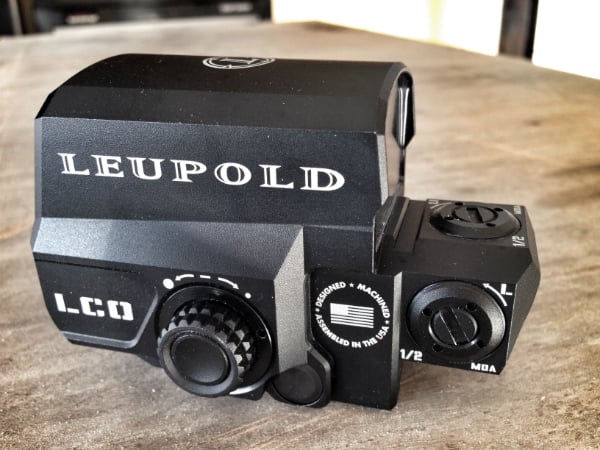



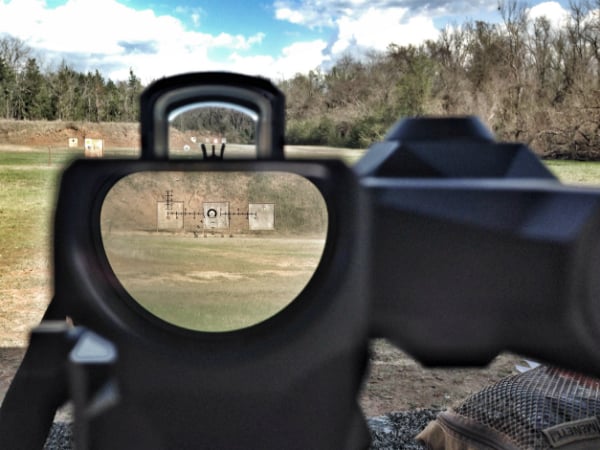
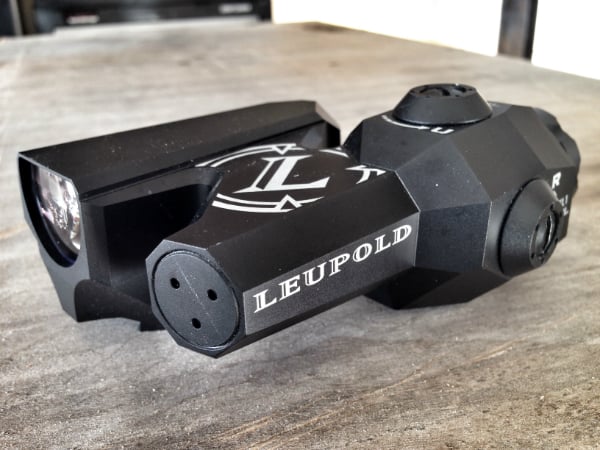
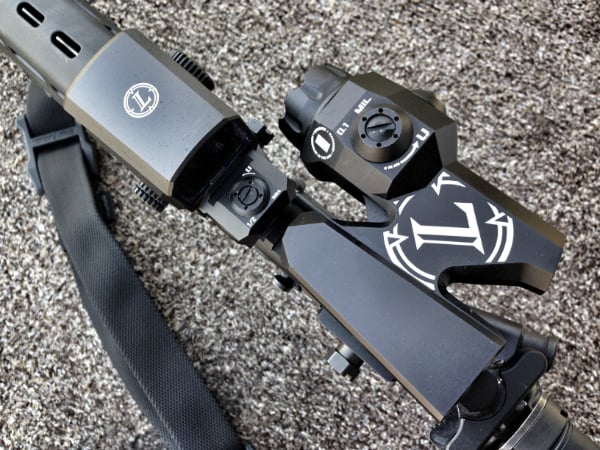
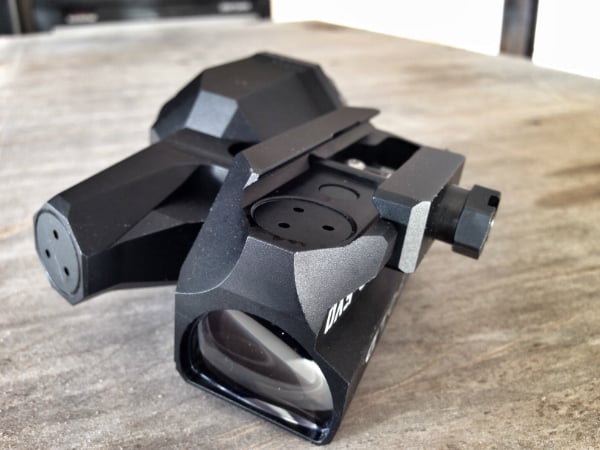

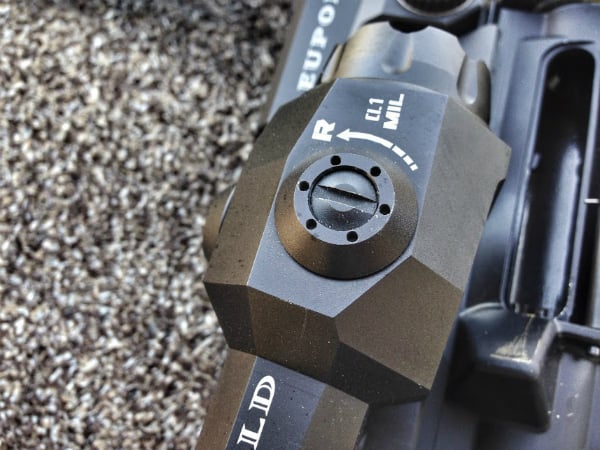



Leave a Reply